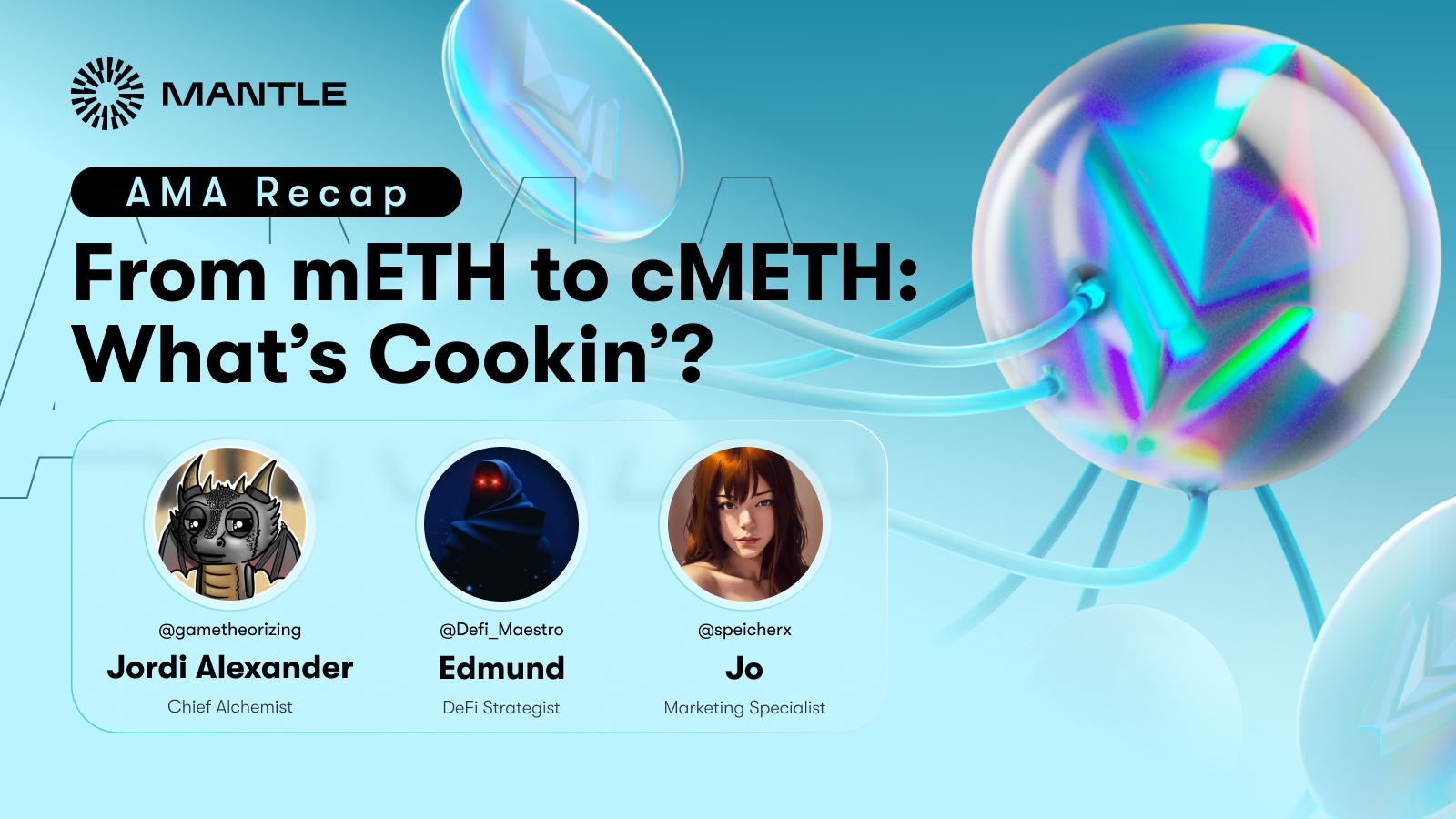The passage of MIP-30 brings significant and exciting developments to Mantle Network, including restaking and the brand new liquid restaking token (LRT), $cMETH. Additionally, we will see the introduction of a brand new governance token, $COOK, for the restaking protocol.
To help unpack all the latest developments of $mETH and $cMETH, and give the community insight into what Mantle is cookin', Jordi (@gametheorizing), Edmund (@Defi_Maestro), and Jo (@speicherx) hosted an AMA to answer all the burning questions the community had. Here's a recap of what was discussed.
Can you introduce cMETH and explain why Mantle expanded into the liquid restaking field?
Edmund: Mantle decided to embark on $cMETH and liquid restaking because we have closely monitored the LRT vertical and noted developments on different chains. We identified key issues that we could address with $cMETH. We felt we could create a significantly better, safer, and more composable solution for users. Unlike some major restaking protocols that don't allow for withdrawals, we wanted to provide an asset that users could utilize to explore various new opportunities without being restricted. $cMETH will be usable throughout Mantle Ecosystem and can interact with multiple protocols.
Jordi: The idea behind $mETH was to bring native yield opportunities to Mantle Ecosystem and provide another way to deliver the best rewards to our users. When the restaking primitive emerged, Mantle wanted to be part of this movement by offering restaking opportunities. Initially, we had a temporary solution of handing out EigenLayer points to $mETH holders on Mantle L2 so they wouldn't feel left out. However, we knew the long-term solution was to make $mETH itself restakable. This brings us to the MIP-30 proposal, which introduces Mantle's approach to restaking through $cMETH, which, as Edmund mentioned, will allow users to use $cMETH throughout Mantle Ecosystem.
Mantle's advantage in being late to the restaking game is that we've observed some of the mistakes and challenges the early adopters faced. One of the issues we are trying to tackle with $cMETH is liquidity fragmentation, as it isn't clear that any single LRT won't fragment liquidity. That's why we've decided to ensure there's a clear restaking solution for $ETH within Mantle Ecosystem.
What is the current state of the restaking landscape, and how can it be improved?
Edmund: The restaking landscape is still relatively new. EigenLayer has been around for a while, but we still have yet to see the full product. Many protocols are monitoring to see how well these AVSs perform and the type of yields users generate through restaking. I think we are just at the beginning of what restaking can potentially bring to the wider space. As time goes on and we see more protocol integrations, it will be exciting to see where it goes. In terms of improvements, we will naturally see progress as protocols figure out what works and what doesn't and as more restaking protocols enter the space.
Jordi: I agree, it's really early. We're not sure how much demand there will be for the restaked assets and how much value will be placed on them. Progress will be slow initially, so I'm quite sure that the skeptics will be right at the beginning.
The bottom line is that there will likely be a wide range of options for restaking, from very risky options where users run the risk of being slashed to very safe ones that offer an extra couple of percent yield. Crypto operates somewhat on hype, and right now, many tokens are being created for these protocols, with everyone trying to get a piece of the restaking space. As the hype continues to grow, so too will the restaking landscape. This is the period in which we will see the most development, and we will adapt to what comes.
Are there any collaborations or alpha we can share regarding cMETH?
Jordi: The idea for $cMETH is for it to be used in other DeFi protocols and use cases, just like $ETH or even $mETH. It should eventually have all the same partnerships and integrations. As it grows, I expect to see it potentially becoming the preferred asset for the ecosystem.
Edmund: You can expect our close ecosystem partners to be involved with $cMETH. For example, we are in discussions with protocols like Pendle and Ethena about potential collaborations. We have many more integrations planned. As Jordi mentioned, we expect $cMETH to become a preferred asset within Mantle Ecosystem, so stay tuned for further announcements.
Can you share some information about the new governance token associated with the restaking protocol?
Jordi: As this will be a separate product, we feel it needs its own governance token, which will be called $COOK. If $cMETH succeeds in attracting a large number of users, community, and TVL, it could attract other chains and communities to adopt and collaborate with it. The exciting thing is that with the governance token, we can give the community and the holders of $mETH and $cMETH rewards, and an active say in the governance decisions that get made — for example, the decisions on which AVSs to use and the direction for integrations and other related matters.
Remember, this is only a recap of what was discussed. If you wish to listen to the entire recording, you can find it here. Also, make sure you follow Mantle on X/Twitter to ensure you don’t miss any updates concerning $cMETH and all the upcoming developments within Mantle Network.
